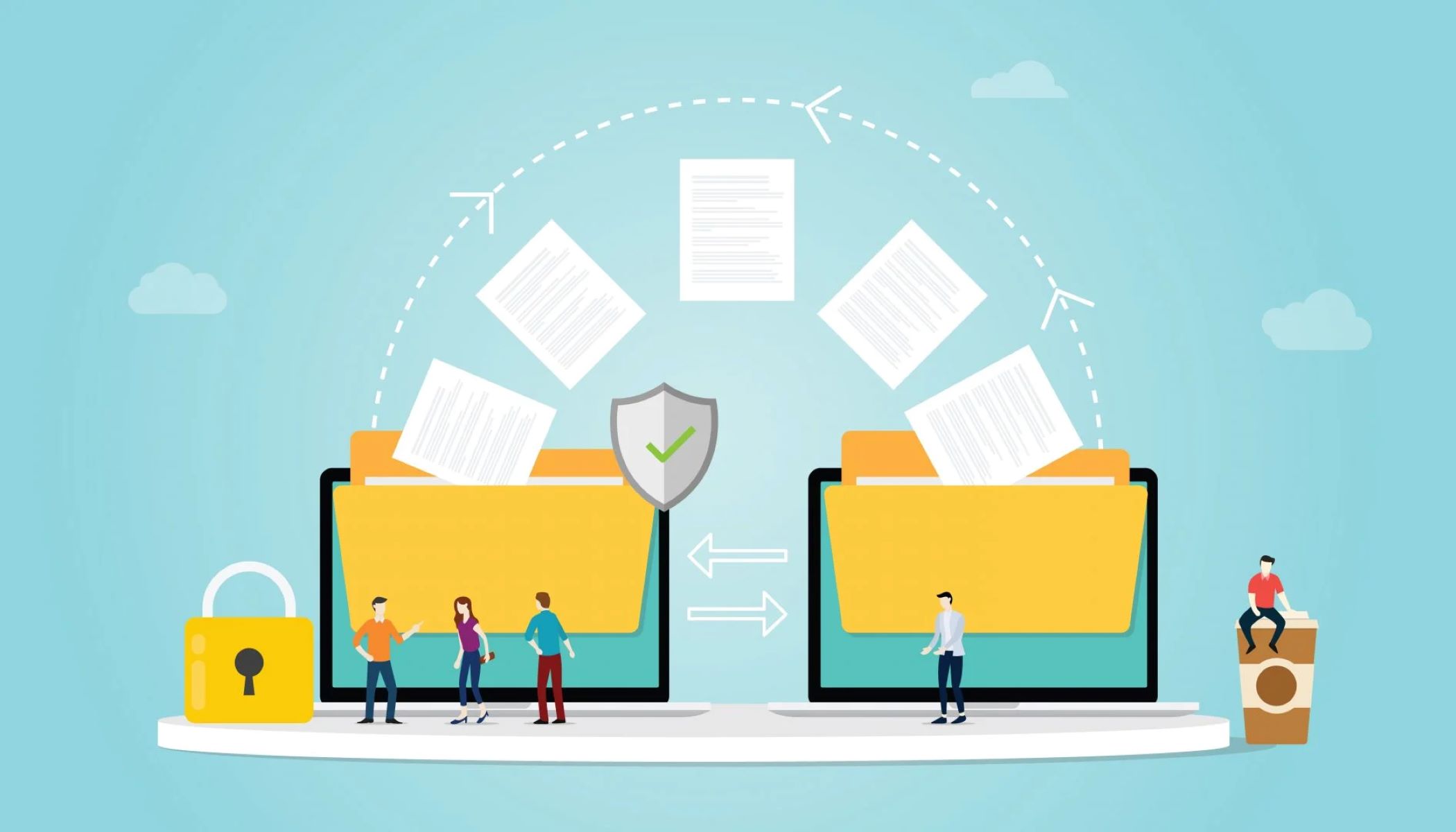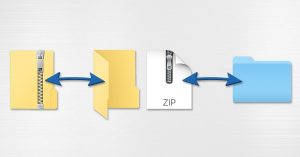Introduction
Welcome to our guide on how to send big files through email. In today’s digital age, sharing large files has become an essential part of our personal and professional lives. Whether you’re sending high-resolution photos, video footage, or important documents, finding effective ways to email large files is crucial.
While email is a convenient and widely used communication medium, it has limitations when it comes to file attachments. Most email providers have strict file size limits, which can prevent you from sending large files directly through email. However, fear not! There are various methods and techniques that you can employ to overcome these limitations and successfully send your big files.
In this article, we will explore different file sharing methods, such as compressing files, splitting large files into smaller parts, and utilizing cloud storage services. Additionally, we will provide you with best practices for sending big files through email and offer troubleshooting solutions for common attachment issues.
Whether you’re a professional photographer, videographer, graphic designer, or simply someone who needs to send large files on a regular basis, this guide will equip you with the knowledge and tools to do so effectively and efficiently.
By the end of this article, you will be able to confidently send big files through email without encountering any size restrictions or compromising the quality of your files. So, let’s dive in and discover the various methods and techniques for successful big file sharing!
Choosing the Right Filesharing Method
When it comes to sending big files through email, it’s important to choose the right file sharing method that suits your needs. While email attachments are the most common way to share files, they have limitations in terms of file size restrictions. Fortunately, there are alternative methods available that can help you overcome these limitations and ensure that your large files reach their intended recipients.
One popular method is to use file compression software to reduce the size of your files. Compression works by removing unnecessary data and reducing the file’s overall size without compromising its quality. There are various compression formats available, such as ZIP, RAR, and 7z, which can be easily created using compression software like WinRAR or 7-Zip. Once your files are compressed, they can be attached to an email and sent without hassle.
Another option is to split large files into smaller parts using file splitting software. This method is particularly useful when dealing with files that exceed the maximum file size limit of your email provider. By splitting a large file into multiple smaller parts, you can send them individually as separate email attachments. The recipient can then download and merge the parts back together using file merging software. This method is especially handy when sending large video files or archives that are too big to send as a single attachment.
If compressing or splitting files seems inconvenient, you can also consider using cloud storage services. Cloud storage providers like Google Drive, Dropbox, and OneDrive offer generous amounts of free storage space, allowing you to upload your large files to the cloud and share them via a simple link. Instead of attaching the files directly to the email, you can insert the link to the file stored in the cloud. This way, recipients can easily access and download the files without worrying about email attachment size limitations.
When choosing the right file sharing method, it’s crucial to consider factors such as the size of the file, the recipient’s accessibility to specific file formats, and the level of convenience you desire. By selecting the appropriate method, you can ensure that your big files are transmitted successfully and received by the intended recipients without any hassle or file size restrictions.
Compressing Files for Efficient Sending
When sending big files through email, one effective method to overcome file size limitations is by compressing the files. File compression reduces the size of your files by eliminating unnecessary data without compromising their quality. This not only allows you to send larger files within the email attachment size limits but also makes the transfer process faster and more efficient.
There are several file compression formats available, such as ZIP, RAR, and 7z. These formats can be created using compression software like WinRAR or 7-Zip, which are widely available for both Windows and Mac systems. Simply select the files you want to compress, right-click, and choose the compress option. The software will then create a compressed file that contains all the selected files.
Before compressing your files, it’s essential to consider the compression level. Most compression software offers options to control the level of compression. Higher compression levels result in smaller file sizes but may take longer to compress and decompress. Conversely, lower compression levels provide faster compression and decompression but may result in slightly larger file sizes.
When compressing files, it’s a good practice to organize them into folders. This helps maintain file organization and ensures that related files remain together when compressing and sending them. Additionally, compressing files that are already in a compatible format, such as images in JPEG format, may not yield significant size reductions. However, it is still worth compressing them to take advantage of slight reductions and optimize the delivery process.
Once you’ve compressed your files, you can easily attach the compressed file to an email. Keep in mind that some email providers may still have file size limits, so it’s important to check their requirements. If the compressed file is still larger than the email attachment limit, you might need to consider alternative methods such as splitting the file or utilizing a cloud storage service.
By compressing your files before sending them through email, you not only ensure that they fit within the attachment size limits but also improve the overall efficiency of the transfer. Compressed files are easier and faster to upload, download, and transmit, saving you and the recipient valuable time and bandwidth.
Splitting Large Files into Smaller Parts
When dealing with large files that exceed the maximum attachment size allowed by your email provider, splitting them into smaller parts is an effective solution. This method allows you to divide the file into manageable chunks and send them as separate email attachments. Once the recipient receives all the parts, they can easily merge them back together using file merging software.
To split a large file into smaller parts, you can use various file splitting software available online. These programs allow you to specify the size of each part or the number of parts you want to create. Once you’ve determined the splitting criteria, the software will divide the large file into smaller segments, usually in the form of numbered or lettered files.
It’s important to consider the size of each part when splitting the file. If the file size limit of your email provider is, for example, 25MB, you may want to split the file into multiple parts of 20MB each to ensure that they can be sent without any issues. By doing so, you are also accounting for the additional data that the email header and other metadata will add to the overall size of the email.
When splitting files, it’s a good practice to use a consistent naming convention for the parts. This could include adding a sequential number or letter to clearly identify the order of the parts. For example, if you split a large video file into three parts, you could label them as “video_part1”, “video_part2”, and “video_part3” to make it easier for the recipient to understand the intended sequence.
While splitting files allows you to bypass email attachment size limits, it’s important to inform the recipient about the process. Include clear instructions in the email on how to merge the parts back together. Provide the recipient with the necessary file merging software or suggest commonly used programs like WinRAR or 7-Zip, which can seamlessly merge the split parts.
It’s worth noting that splitting large files into smaller parts may increase the risk of data loss or corruption, as each part is dependent on the successful delivery of the others. To minimize this risk, consider using file compression software to create a compressed file that contains all the split parts. This way, you ensure that all parts remain intact and can be easily merged by the recipient.
By splitting large files into smaller parts, you can overcome email attachment size restrictions and successfully send your big files. This method ensures that your files reach the recipient without any issues, and by providing clear instructions on how to merge the parts, you can facilitate a seamless and hassle-free file retrieval process.
Using Cloud Storage Services
When it comes to sending big files through email, one efficient and convenient method is to utilize cloud storage services. Cloud storage providers like Google Drive, Dropbox, and OneDrive offer generous amounts of free storage space, allowing you to easily upload your large files and share them via a simple link.
To get started, create an account with a cloud storage service of your choice. Once you’re logged in, you can upload your big files to the cloud storage platform. Most providers offer an intuitive and user-friendly interface where you can simply drag and drop your files or use a dedicated upload button.
After uploading your files, the cloud storage service generates a unique URL for each file. This URL is essentially a direct link to the file stored in the cloud. Instead of attaching the large file to an email, you can simply insert this link into your email message, allowing the recipient to access and download the file with ease.
Cloud storage services provide several advantages when it comes to sharing large files. Firstly, they bypass the attachment size limits imposed by email providers, allowing you to share files of any size. Secondly, by utilizing a link-based approach, you eliminate the need for the recipient to download the entire file at once. They can choose to download the file when convenient, saving bandwidth and ensuring a smooth download process.
When sharing files through cloud storage services, it’s important to consider the privacy and security of your data. Most providers offer options to control who can access the files. You can choose to keep the files private and only share the link with specific recipients or make the files publicly accessible for anyone with the link. It’s wise to assess the sensitivity of the data you’re sharing and adjust the sharing settings accordingly.
Additionally, some cloud storage services offer collaboration features that allow multiple users to access and edit files simultaneously. This is especially useful for projects that require real-time collaboration and feedback. By granting access to the relevant individuals, you can collaborate seamlessly without the need for constantly sending updated versions of files through email.
By using cloud storage services, you can effortlessly send large files through email without worrying about size restrictions. The convenience, flexibility, and additional features offered by these services make them an excellent choice for individuals and businesses alike. Embrace the power of the cloud, and enjoy efficient file sharing that goes beyond the limitations of traditional email attachments.
Sending Big Files Through Email
Email has long been the go-to method for communication, but it does come with limitations when it comes to sending big files. However, with a few smart strategies and techniques, you can successfully send large files through email.
The first step is to be aware of the file size limits set by your email provider. Most providers have a maximum attachment size limit, typically ranging from 10MB to 25MB. If your file exceeds this limit, you will need to explore alternative methods. However, if your file is slightly larger, there are still a few tricks you can use to send it via email.
One option is to compress the file using compression software like WinRAR or 7-Zip. Compressing the file can significantly reduce its size, making it within the attachment limit. Simply right-click on the file, select the compress option, and choose a compression format, such as ZIP or RAR. Attach the compressed file to your email, and you’re good to go.
If the compressed file is still too large, you can consider splitting it into smaller parts. File splitting software allows you to divide the file into manageable chunks, which can be sent as separate email attachments. Include clear instructions for the recipient on how to merge the parts back together using file merging software.
In cases where compression and splitting are not sufficient, or you prefer a more convenient method, cloud storage services can come to the rescue. Services like Google Drive, Dropbox, and OneDrive offer ample storage space where you can upload your large files. Once uploaded, simply share the file via a link in your email. This way, the recipient can download the file directly from the cloud storage platform.
When sending large files through email, it’s important to be mindful of the recipient’s email provider and internet connection. Some providers may have stricter attachment size limits or slower download speeds, which can affect the successful delivery and accessibility of the file. Consider communicating with the recipient beforehand to ensure they can receive and access the large file.
Lastly, keep in mind that email should not be the sole method of sharing big files, especially if they exceed several hundred megabytes or gigabytes in size. For extremely large files, it’s often more practical to utilize dedicated file transfer services or physical storage devices, such as external hard drives or USB flash drives, to ensure secure and efficient delivery.
With these strategies in mind, you can confidently send big files through email, maximizing the chances of successful delivery while staying within the attachment size limits imposed by email providers.
Best Practices for Sending Big Files Through Email
When it comes to sending big files through email, following best practices ensures a smooth and successful file transfer. Here are some guidelines to keep in mind:
1. Check attachment size limits: Before sending any file, confirm the maximum attachment size allowed by your email provider. This will help you determine if the file can be sent as a single attachment or if alternative methods should be used.
2. Compress files whenever possible: Use compression software to reduce the file size before attaching it to an email. Compressed files not only fit within attachment limits but also transfer faster, improving efficiency.
3. Split large files into smaller parts if necessary: When the compressed file is still too large, consider using file splitting software to divide it into smaller segments. Include clear instructions for the recipient on how to merge the parts back together.
4. Utilize cloud storage services: Take advantage of cloud storage platforms such as Google Drive, Dropbox, or OneDrive to upload and share large files. Instead of attaching the file to the email, insert a link to the file stored in the cloud.
5. Provide clear instructions to the recipient: If you choose to compress, split, or use cloud storage, ensure that the recipient knows the steps to access and retrieve the files. Include clear and concise instructions in the email to eliminate any confusion.
6. Be mindful of file formats: Consider the compatibility of the file formats you are sending. Choose universally supported formats, such as PDF for documents or JPEG for images, to ensure that the recipient can easily access and open the files.
7. Double-check before sending: Before hitting the send button, double-check that you have attached the correct file and that it is not corrupted. Taking this extra precaution can save you from embarrassing and time-consuming mistakes.
8. Communicate with the recipient: If you are sending a particularly large file, it is a good idea to notify the recipient in advance. This way, they can prepare their mailbox and ensure their internet connection is sufficient to download the file.
9. Consider alternative file transfer methods: For extremely large files or sensitive data, consider using dedicated file transfer services or physical storage devices like external hard drives. These methods provide more secure and efficient delivery in certain cases.
10. Maintain data privacy and security: If your files contain sensitive or confidential information, take steps to protect them. Password-protect compressed files or encrypt them to ensure that only the intended recipient can access the data.
By following these best practices, you can send big files through email efficiently while minimizing the risk of delivery issues or security concerns. Adapt the methods according to the specific needs of the recipient and the nature of the files being sent.
Troubleshooting Common Email Attachment Issues
Sending email attachments can sometimes be a tricky process, and various issues can occur along the way. Here are some common problems you might encounter when sending big files through email and how to troubleshoot them:
1. File size exceeds attachment limit: If your file exceeds the maximum attachment size allowed by your email provider, consider compressing the file or splitting it into smaller parts as discussed in the previous sections. This will help ensure that the file can be sent successfully.
2. Email bounce-backs: In some cases, your email may be returned, or “bounced back,” to your inbox. This can happen if the recipient’s mailbox is full or if the file is flagged as spam. In these situations, try sending the file through an alternative method, such as using a cloud storage service or a dedicated file transfer service.
3. Slow upload or download speeds: Large files can take a significant amount of time to upload or download, depending on the internet connection speeds of both the sender and the recipient. If you encounter slow speeds, try using a faster and more stable internet connection or consider using a file transfer service specifically designed for big files.
4. Incompatible file formats: Ensure that you are sending files in formats that are widely supported by various operating systems and devices. For documents, PDF is generally a safe and compatible choice. For images, JPEG is widely recognized. If unsure, communicate with the recipient to confirm their compatibility requirements.
5. Corrupted file attachments: Occasionally, file attachments may become corrupted during the process of sending or receiving. To avoid this, always verify the integrity of the file before sending by opening and checking it. If a file does become corrupted, resend it or use a file compression or splitting method to send it in a more reliable manner.
6. Limited email storage: Some email providers have storage limits for individual mailboxes. If you consistently send and receive large files through email, ensure that you regularly clean up your mailbox to free up storage space. Alternatively, consider using a cloud storage service or file transfer service that provides more generous storage options.
7. Security concerns: If you are sending sensitive or confidential files, it’s important to consider the security of the file during transit. Ensure that you use secure connections (such as SSL/TLS) when sending and receiving emails. Additionally, consider encrypting the file or using a password-protected archive to provide an extra layer of protection.
8. Recipient’s email provider limitations: Different email providers may have varying attachment size limits or may restrict certain file types due to security concerns. Be aware of the restrictions that the recipient’s email provider may have and communicate with them to determine the best method for sending the file.
By being aware of these common email attachment issues and knowing how to troubleshoot them, you can overcome obstacles and successfully send big files through email. Adapt your approach and method based on the specific situation and the requirements of both the sender and the recipient.
Conclusion
Sending big files through email can be a challenge due to attachment size limits imposed by email providers. However, by employing effective strategies and techniques, you can overcome these limitations and successfully send large files.
In this guide, we explored various methods for sending big files through email. We discussed the importance of choosing the right file sharing method, such as file compression, splitting files into smaller parts, and utilizing cloud storage services. Each method has its advantages and is suitable for different scenarios based on the file size, recipient preferences, and convenience.
We also highlighted best practices to follow when sending big files through email, including checking attachment size limits, compressing files, providing clear instructions to recipients, and considering alternative file transfer methods when necessary. By adhering to these best practices, you can ensure a smooth and efficient file transfer process.
Additionally, we explored troubleshooting tips for common email attachment issues, such as file size limitations, slow upload or download speeds, and compatibility concerns. By being aware of these potential issues and knowing how to troubleshoot them, you can overcome obstacles and successfully transfer your big files.
Remember to prioritize data privacy and security when sending big files, especially if they contain sensitive or confidential information. Take appropriate measures to encrypt files, use password protection, or leverage secure connections to safeguard your data during transit.
While email is a popular and convenient communication tool, it may not always be the most effective method for sending extremely large files. In such cases, consider utilizing dedicated file transfer services or physical storage devices to ensure secure and efficient delivery.
By understanding the limitations of email attachments and utilizing the strategies and techniques mentioned in this guide, you can confidently send big files through email without compromising their quality or exceeding attachment size limits. Embrace these methods, adapt them to suit your needs, and simplify the process of sharing large files.

























